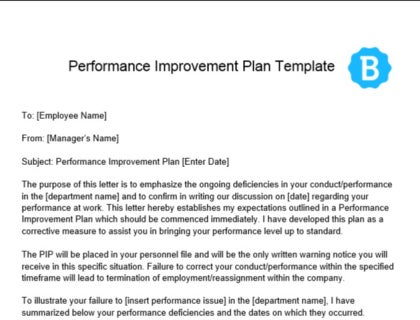Performance Improvement Plan Template:
To: [Employee Name]
From: [Manager’s Name]
Subject: Performance Improvement Plan [Enter Date]
The purpose of this letter is to emphasize the ongoing deficiencies in your conduct/performance in the [department name] and to confirm in writing our discussion on [date] regarding your performance at work. This letter hereby establishes my expectations outlined in a Performance Improvement Plan which should be commenced immediately. I have developed this plan as a corrective measure to assist you in bringing your performance level up to standard.
The PIP will be placed in your personnel file and will be the only written warning notice you will receive in this specific situation. Failure to correct your conduct/performance within the specified timeframe will lead to termination of employment/reassignment within the company.
To illustrate your failure to [insert performance issue] in the [department name], I have summarized below your performance deficiencies and the dates on which they occurred.
[List performance deficiencies and dates e.g. absenteeism, failure to meet targets, poor attitude, etc.]
Corrective Action Required
[Give a detailed description of the corrective action required]
You are hereby placed on a Performance Improvement Plan until [insert date/timeframe] and are expected to adhere to the plan as stated above.
My supervisor has discussed the above performance improvement plan with me. I understand and acknowledge the contents and the potential consequences of noncompliance.
[Employee Name]
[Employee Signature] [Date]
[Supervisor Name]
[Supervisor Signature] [Date]

PIP Sample Download:
Download this free performance improvement plan example in Microsoft Word format.
Download LetterWhen to Use:
If an employee is not performing up to standard within an organization, management may prefer to offer the employee an opportunity to rectify their errant behavior and avoid a disciplinary hearing, suspension, or termination. In this case, a manager or HR representative will draft a PIP to give to the employee.
1. If the employee is underperforming or not displaying the level of professionalism expected.
Any action that affects the performance or success of a business is deemed inappropriate. A performance improvement plan letter will outline the employee's performance issues and provide steps to be taken to improve within a certain timeframe.
2. You want legal protection for the company.
A performance improvement plan is important to protect your company from unfair dismissal claims. It is a document stating that due diligence has been followed and that the employee understands that if he/she has not made the necessary improvements, there is a possibility of dismissal or demotion.
3. You want to provide the employee with important information.
The performance improvement action plan is a detailed document that clearly states the unacceptable performance observed, improvement objectives, process, and final step (reassignment or dismissal) should the employee not meet their objectives.


